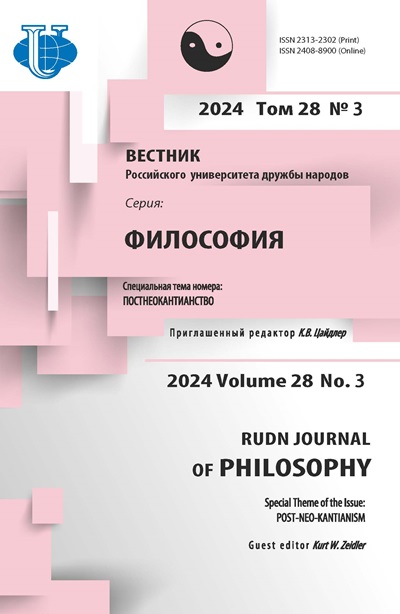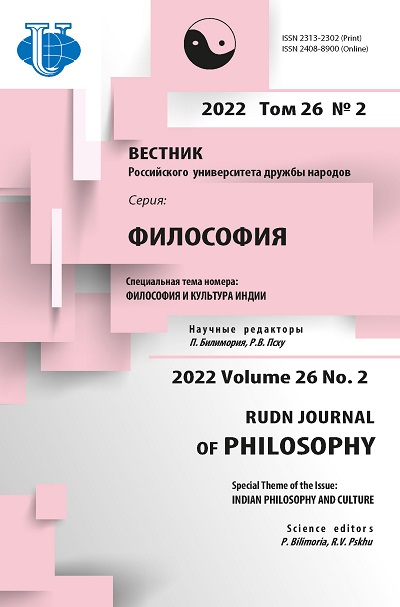О возможности двойственной природы «Я»
- Авторы: Вайдья А.Д.1
-
Учреждения:
- Университет Сан-Хосе
- Выпуск: Том 26, № 2 (2022): ФИЛОСОФИЯ И КУЛЬТУРА ИНДИИ
- Страницы: 285-304
- Раздел: ФИЛОСОФИЯ И КУЛЬТУРА ИНДИИ
- URL: https://journals.rudn.ru/philosophy/article/view/31365
- DOI: https://doi.org/10.22363/2313-2302-2022-26-2-285-304
Цитировать
Полный текст
Аннотация
В статье исследуется компатибилизм и инкомпатибилизм в отношении вопроса о том, может ли «я» одновременно быть и субъектом, и объектом в одном и том же осознавании в одно и то же время. Дискуссии на эту тему ведутся очень давно, свой вклад в рассмотрение данной проблемы внесли многие традиции философии; моей отправной точкой в данном случае выступает работа А.К. Мукерджи (современного индийского философа), который работал над возможностью самосознания, сформулировав парадокс эгоцентричности. В рамках рассмотрения дискуссии о компатибилизме я также обращаюсь к Патанджали (индийскому философу классической эпохи), Морису Мерло-Понти (представителю феноменологии) и Ариндаме Чакрабарти (современному индийскому аналитическому философу). Вначале представлен парадокс Мукерджи, затем я критически анализирую аргументы Патанджали и Мерло-Понти против инкомпатибилизма. Далее парадокс Мукерджи сопоставляется с аргументами Чакрабарти в пользу компатибилизма. Представлен авторский критический обзор аргументов Чакрабарти в пользу компатибилизма и против инкомпатибилизма: несмотря на проницательность и силу данных аргументов, все же, рассматривая их наряду с парадоксом Мукерджи, я предлагаю противопоставить им свой аргумент в защиту компатибилизма. Данный аргумент основан на аналогии с принципом корпускулярно-волнового дуализма в квантовой физике, и связи между мыслимостью и метафизической модальностью.
Ключевые слова
Об авторах
Ананд Джайпракаш Вайдья
Университет Сан-Хосе
Автор, ответственный за переписку.
Email: anand.vaidya@sjsu.edu
ORCID iD: 0000-0002-0529-8876
профессор философии
США, 95192, Сан-Хосе, Калифорния, пл. Вашингтона, 1Список литературы
- Vaidya A. The Paradox of Ego-centricity. Sophia: Journal of International Philosophy and Traditions. 2019;58(1):25-30.
- Bhushan N, Garfield J. Minds Without Fear. Oxford: Oxford University Press; 2018.
- Evans G. The Varieties of Reference. Edited by John McDowell. Oxford: Oxford University Press; 1982.
- Kaplan D. Demonstratives: An Essay on the Semantics, Logic, Metaphysics and Epistemology of Demonstratives and Other Indexicals. In: Almog J, Perry J, Wettstein H. (editors). Themes from Kaplan. Oxford: Oxford University Press; 1989. P. 481-563.
- Ganeri J. Naturalism, Consciousness, and the First-Person Stance. Oxford: Oxford University Press; 2012.
- Chakrabarti A. Does Self-Awareness Turn the Self into an Object? In: Realisms Interlinked: Objects, Subjects and Other Subjects. London: Bloomsbury; 2020. P. 137-144.
- Ashton G. The Puzzle of Playful Matters in Non-Dualism Śaivism and Sāṃkhya: Reviving Prakṛti in the Sāṃkhya Kārikā through Goethean Organics. Religions. 11(5), 221. https://doi.org/10.3390/rel11050221
- Merleau-Ponty M. Phenomenology of Perception [Smith C, translator]. London: Routledge and Kegan Paul; 1962.
- Mishra RS. The Yoga Sūtras of Patañjali. New York: Baba Bhagvandas Publications Trust; 1987.
- Dreyfus H. Overcoming the Myth of the Mental. Topoi. 2006;(1-2):43-49.
- Csíkszentmihályi M. Flow. New York: Harper Collins Publishing; 1990.
- Vaidya A. Public-Philosophy: Cross-Cultural and Multi-Disciplinary. Journal of Comparative Philosophy. 2015;6(2):35-57.
- Shoemaker S. Causal and Metaphysical Necessity. Pacific Philosophical Quarterly. 1998;79(1):59-77.
- Priest G, Berto F, Weber Z. Dialetheism. In Zalta EN, editor. The Stanford Encyclopedia of Philosophy (Fall 2018 Edition). 2018. Available at: https://plato.stanford.edu/archives/fall2018/entries/dialetheism/
















